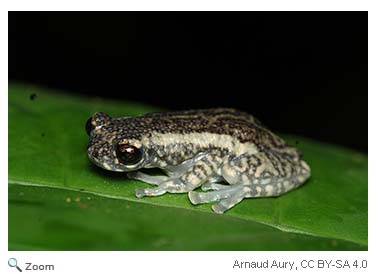Allophrynidae - Tukeit Hill Tree Frogs |
|
|
|
 There are only two species in this family. The Tukeit Hill tree frog (Allophryne ruthveni) is found in
South America in
French Guiana, Venezuela, Surinam, Brazil, and Bolivia. There are only two species in this family. The Tukeit Hill tree frog (Allophryne ruthveni) is found in
South America in
French Guiana, Venezuela, Surinam, Brazil, and Bolivia.
It is tiny - only an inch in length. It can vary in color from black with yellow spots and stripes to yellow with black spots and stripes.
It spends part of its time in trees, but it also spends time on the ground. Males gather around ponds during the breeding season and call out to females. The female lays her eggs on leaves above the pond.
The second species, Allophryne resplendens, was only recently identified. It is found in Peru.
World Status Key
 Least Concern Least Concern  Near Threatened Near Threatened  Vulnerable Vulnerable  Endangered Endangered  Critically Endangered Critically Endangered  Extinct in Wild Extinct in Wild  Extinct Extinct  Not Enough Data Not Enough Data
Status and range is taken from ICUN Redlist.
U.S. Status Key
 Threatened in US Threatened in US  Endangered in US Endangered in US  Introduced Introduced
Status taken from US Fish and Wildlife. Click on U.S. status icon to go to the U.S. Fish and Wildlife species profile.
New Hampshire Status Key
 Threatened in NH Threatened in NH  Endangered in NH Endangered in NH  Breeds in NH (birds) Breeds in NH (birds)
Status taken from NH Fish and Game
Location Key
 Africa Africa  Asia Asia  Australia/Oceania Australia/Oceania  Europe Europe  North America North America  South America South America  NH NH
More Info
 Click for More Info Click for More Info  Click for Image Click for Image
Resource Key
 Profile Profile  Photos Photos  Video Video  Audio Audio
Location Key
 Africa Africa  Asia Asia  Australia/Oceania Australia/Oceania  Europe Europe  North America North America  South America South America  NH NH  Click for More Info Click for More Info  Click for Image Click for Image
New Hampshire Species
None
North/Central American Species
None
Species Around the World
Tukeit Hill Tree Frog - Allophryne ruthveni    
Allophryne resplendens  
Additional Information
Allophryne resplendens   
Allophryne resplendens is found in Peru.
Source: Amphibiaweb Intended Audience: General Reading Level: High School
Tukeit Hill Tree Frog - Allophryne ruthveni     
The Tukeit hill tree frog is found in Brazil; French Guiana; Guyana; Suriname; Venezuela, and Bolivia.
Source: Amphibiaweb Intended Audience: General Reading Level: High School
Tukeit Hill Tree Frog - Allophryne ruthveni   
The Tukeit hill tree frog is sometimes placed in the Centrolenidae family.
Source: Animal Diversity Web Intended Audience: General Reading Level: High School
|

